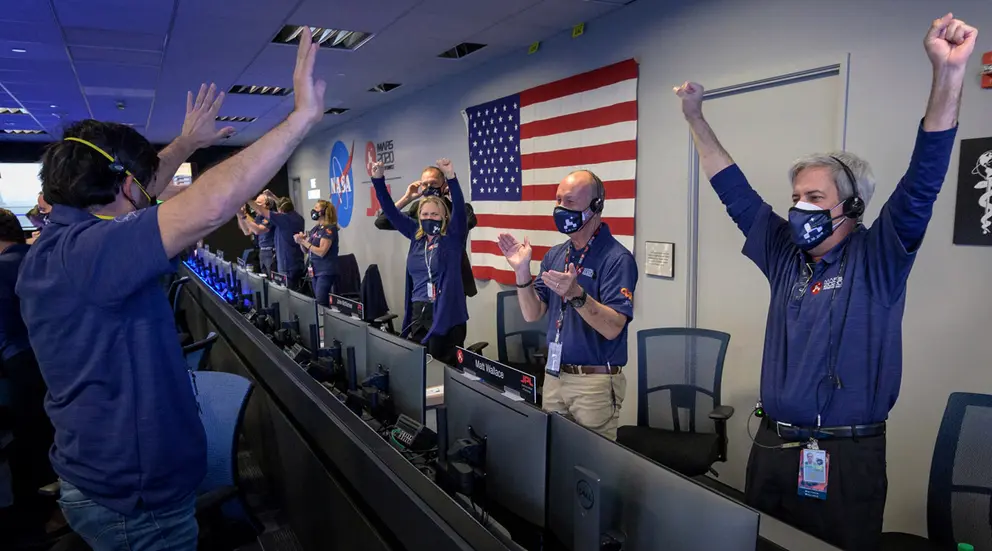NASA's Mars rover Perseverance landed on the Red Planet on Thursday after a roughly 480-million-kilometre journey through space, the first probe from Earth to reach the Martian surface since 2018.
"Touchdown confirmed, Perseverance safely on the surface of Mars," a NASA announcer said as their command centre erupted in applause.
The landing sequence, known as the "Seven Minutes of Terror," saw Perseverance enter Mars' atmosphere at a speed of 20,000 kilometres per hour before deploying a parachute to rapidly slow its descent and thrusters to navigate the landing.
Since it takes more than 11 minutes for the NASA team to receive a radio signal back from Mars, the entire process was conducted autonomously.
Shortly after landing, Perseverance sent two grey images of the Mars surface and will begin sending higher-quality images back to Earth later in the day.
"Hello, world. My first look at my forever home," the Perseverance Twitter account read, alongside an image of the surface.
Perseverance travelled through space for nearly seven months after launching from Cape Canaveral in Florida.
Landed in a crater
The rover has landed in a massive crater called Jezero, the site of a 3.5-billion-year-old former lake that scientists say could provide evidence that microbes previously existed on Mars. Mars had water on its surface billions of years ago, a fact that has led to speculation that there may have been some form of life on the planet.
"We're trying to land the biggest, heaviest and most complex rover we've ever built at the most dangerous landing site we've ever attempted," Al Chen, who leads entry, descent and landing operations for Perseverance said earlier Wednesday.
"Jezero may look great and promising from a science perspective, but it's absolutely treacherous for landing," Chen added.
Perseverance is expected to study the Mars surface for at least two years as it examines the climate and geology and collects rock and soil samples.
The samples will be stored in 43 hermetically sealed tubes and eventually deposited on the Martian surface in hopes of one day being returned to Earth in a separate mission.
The rover joins NASA's InSight lander, which has been on the Martian surface since 2018, providing weather reports and earthquake data among other phenomena.
The Curiosity rover, which NASA landed on Mars in 2012, is still operational on the surface, where it has been exploring a mountain since 2014 and providing photos and weather reports.
The latest Curiosity weather report recorded a high of -16 degrees Celsius and a low of -72 degrees
According to NASA the roughly 2.7-billion-dollar rover project will help pave the way for human exploration of the Red Planet.
Ancient microbial life
The rover, which NASA has hailed as its "most sophisticated" ever sent to Mars, is a technological feat equipped with seven instruments that will help it examine evidence of ancient microbial life on the planet.
Among the instruments carried by Perseverance, which is the size of small car, are state-of-the-art cameras with with panoramic capabilities and ability to zoom in on rock textures from a 100 metres away.
Another camera, the SuperCam, will zap rocks with a laser to study the vapour.
One particularly vital instrument, known as SHERLOC, also uses a laser to search for organic material and minerals that may have been altered by water, giving key insights into the signs of past life.
The 1,040-kilogram rover has a helicopter drone named Ingenuity strapped to its belly, which could become the first craft to fly on another planet.
NASA has previously conducted eight successful Mars landings, while Perseverance is the fifth NASA rover on Mars.
This latest mission is part of the Artemis programme, which aims to land people on the moon by 2024 and establish a sustained human presence there by 2028, as part of its efforts to get astronauts to Mars.
It is part of a recent flurry of Earth explorers sent to Mars. Probes from China and the United Arab Emirates have reached Mars in recent weeks, but are only orbiting the planet for now.










